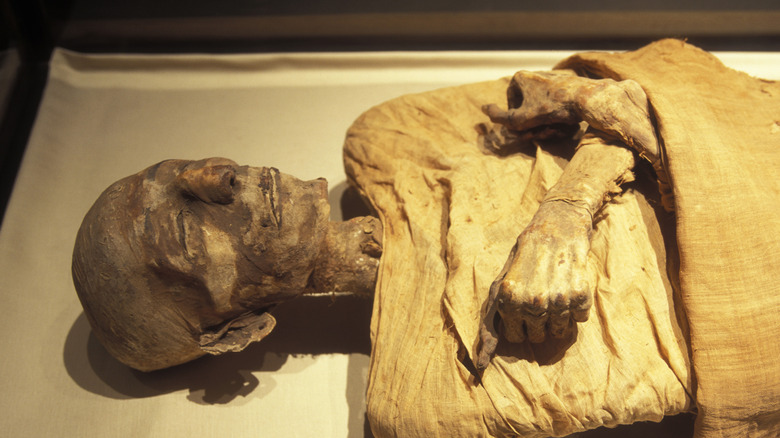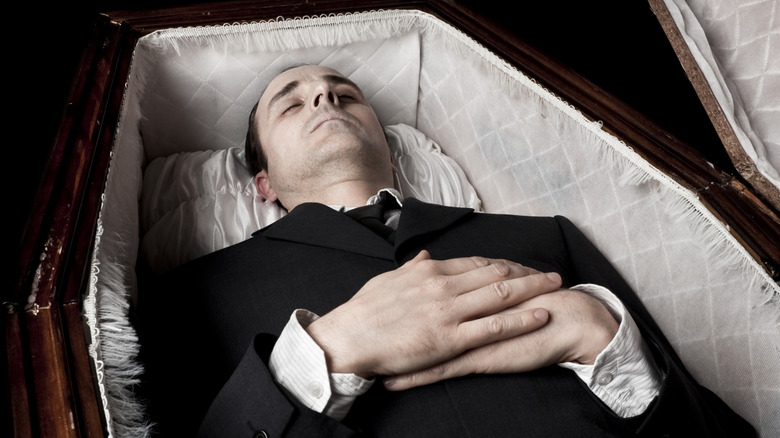Why Are The Arms Of A Dead Person Crossed When They're Buried?
The image of a corpse in a coffin with its arms crossed to form an "X" over its chest is a common image in popular culture. It brings to mind old vampire movies and ancient Egyptian mummies. While most of us probably haven't seen a dead body at a funeral in that position, the imagery has cemented itself in the canon of burial representation. It makes sense that we associate the position with death since some of the best known depictions of buried people come from ancient Egypt, as previously mentioned.
The original mummies discovered with their arms crossed over their chest were from circa 1500 BCE, and if a mummy was positioned that way, it was because it was a pharaoh. But that positioning was mostly just in the Egyptian New Kingdom period, not necessarily throughout the country's various empires. Some point to a depiction of the god Osiris from 2300 BCE as the inspiration for the crossed-arm pharaoh mummies' positioning. In that artwork, he has his arms crossed across his chest and is holding a flail in one hand and a crook in the other. Though Osiris isn't always shown with crossed arms, he was said to symbolize death, the renewal of life on Earth, and whatever awaited us in the afterlife.
Crossed arms were a theme for thousands of years
The Roman empire eventually conquered Egypt, and those who lived among the ancient cultural relics were greatly influenced by them. Soon enough, regular folks were often buried with their arms crossed across their chest. That said, they were buried other ways too, as archeologists discovered. Much like today, unearthed bodies show that hands may be crossed over the chest, at the corpse's side, or folded on top of one another near the pelvis.
By the Middle Ages, burial positions were much the same. We have to take into account that lots of bodies have been buried over the centuries, so there was a lot of variety. A 2020 PLOS One Study examined bodies buried in the area that is now Germany and its neighboring nations, during a period spanning from the High Middle Ages in the 10th century to the early modern period ending in the 19th century. And during this time, it was considered "normal" to bury bodies with the arms crossed over the chest. At this point, it's unclear if there was any real reason for it. While it may have started as an homage to the gods from those perceived to be gods on earth, arms crossed at burial may have simply become tradition.
Crossed arms among the dead are uncommon in modern times
These days, crossing arms over the chest before burial isn't really a thing. According to funeral director and embalmer Kari Northey, hand positioning these days is typically either one hand on top of the other just below the belly, or straight at the sides. In a YouTube video titled, "Positioning of bodies: Tips to get someone positioned in a casket just right," she explains the do's and don'ts of how to place hands, and nowhere does she mention the crossed arms on the chest. The closest she gets is having one hand on top of the other while lying on the chest, and that's one she says you never want to do because it presses the arms too tightly together at the elbows and causes the hands to "hover." Seemingly, the placement of the arms in an "X" across the chest is so archaic it's not even something worth mentioning.
Morty Stein, a California mortician who answers questions on TikTok, appears to agree. He says the positioning of the hands is completely up to families, so we assume they probably could cross the deceased's arms across their chest if they wanted to. But according to Stein, it's typically arms down at the sides or one hand on top of the other on the abdomen.


